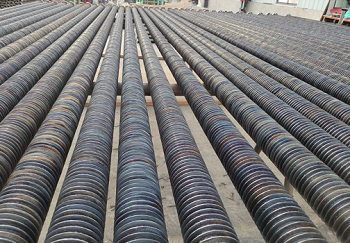Under the wave of today's booming industry, energy saving and high efficiency have become the core goals pursued in various fields. As a shining pearl in the field of heat exchange, finned tubes are gradually entering the public's field of vision, providing excellent solutions for the heat exchange needs of many industries.

From the appearance, finned tubes are tightly attached to the surface of the base tube with wing-like fins. These fins are not simply decorations, they greatly expand the heat exchange area. Taking the common air-conditioning condenser as an example, after using finned tubes, the originally limited heat exchange area outside the tube increases several times or even dozens of times in an instant. This means that in the same time, the efficiency of heat exchange has been leapfrogged, making the cooling or heating process faster, creating a comfortable environment for users while reducing energy consumption.
In terms of materials, the finned tube family is rich and diverse, covering a variety of materials such as aluminum alloy, copper, and stainless steel. Aluminum alloy finned tubes have been widely used in civil fields such as air conditioning and ventilation due to their excellent thermal conductivity, light weight and relatively affordable cost; copper finned tubes have gained a firm foothold in the chemical and pharmaceutical industries with extremely high heat exchange requirements and harsh environments with their super corrosion resistance and excellent thermal conductivity, ensuring the long-term stable operation of the heat exchange system; stainless steel finned tubes are even more durable as a rock, and are not afraid of extreme working conditions such as high temperature, high humidity, strong acid and alkali, and are very useful in food processing, marine engineering and other fields.
In terms of manufacturing technology, the forming technology of finned tubes is also becoming more mature. The expansion process cleverly uses mechanical force or hydraulic pressure to make the fins fit tightly on the base tube, ensuring a low thermal resistance connection between the two and smooth heat transfer; the welding process uses precision welding to make the fins and the base tube an unbreakable whole, which is especially suitable for harsh working conditions of high temperature and high pressure, and escorts the heat exchange link of large industrial projects such as petroleum and electricity.
With the continuous advancement of science and technology, the research and development and innovation of finned tubes are still continuing to advance. Researchers are working to optimize the shape of fins, increase fin density, further tap their heat transfer potential, and explore new composite materials, striving to find a perfect balance between performance improvement and cost control. It can be foreseen that finned tubes will continue to shine in the future industrial development journey, helping all walks of life to move towards a higher peak of energy efficiency.
Whether it is enjoying a cool indoor environment in the hot summer, or continuously producing high-quality products on industrial production lines, finned tubes are working silently behind the scenes, injecting a steady stream of power into a better life and economic take-off with efficient heat exchange.

